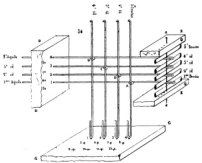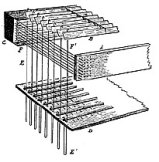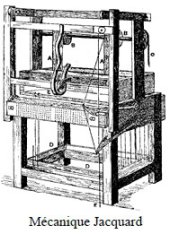- Home
- Resurrection ▾
-
Learn ▾
- Free library
- Glossary
- Documents
- Initiation
-
Shaped fabrics
- Introduction
- Popularization
- Definitions
- Le métier de façonné
- Principes du façonné
- Mécaniques de façonné
- Le jeu des crochets
- Les cartons
- Chaîne des cartons
- Mécanique 104 en détail
- Pour en finir
- Montage façonné
- Empoutage 1/3
- Empoutage 2/3
- Empoutage 3/3
- Punching, hanging and dip
- Autres façonnés
- Façonnés et Islam
-
Cours de tissage 1912
- Bâti d'un métier
- Le rouleau arrière
- Les bascules
- Formation du pas
- Position de organes
- Mécanique 104 Jacquard
- Fonctionnement 104
- Lisage des cartons
- Le battant du métier
- Le régulateur
- Réduction et régulateur
- Mise au métier d'une chaîne
- Mise en route du métier
- Navettes à soie
- Battage
- Ourdissage mécanique
- Préparation chaînes et trames
- Equipment ▾
- Chronicles ▾
- Fabrics ▾
- Techniques ▾
- Culture ▾
- Language ▾

The Jacquard craft is, in short, an ordinary craft, but equipped with this mechanism for lifting the warp threads. This mechanism, which seems complex at first sight, is actually quite easy to understand, at least in principle.
The wires, called arcades, connect the wires of the chain vertically to the heel I 'of the hooks E. Lifting a hook is like raising an arch and therefore one (or a few) threads of the chain. The hooks E, also bent at their upper part, have this curved tip engaged on blades, without being integral therewith. They rest simply on top of them, so that if an upward movement is impressed on the fixed assembly of these plates, the latter will in their ascending motion carry all the hooks which rest upon them, and hence the arcades attached to These hooks and the warp threads connected to these arches. Each hook passes through the eye of a corresponding horizontal needle and one of the ends of which presses against a small (elastic) spring placed in the elastic box , Which returns it to its initial position, ie above the blade. The other end of the needle passes through a plank, a few millimeters beyond it. It will be readily understood that by pressing with the finger on this free end of the needle it will crush the spring placed at the other end and move laterally. As it moves, its eye, which is traversed by a hook, pushes back that eighth-note whose curved upper end will no longer be in mesh with the blade. If, therefore, at this time, the assembly integral with the blades is lifted, the hook will not be carried by a blade. It will remain in place as well as the arch which is suspended and the corresponding warp thread ... Instead of our finger which has repelled a needle, if a cardboard is strongly affixed to the set of needles, Is the totality of the needles which will be repelled as with our finger. All the hooks will follow the movement (via the eyes that trap them), and if the blades are lifted, no hook will be drawn, therefore no warp thread. Now, if we drill small holes in our cardboard, in front of some needles, well when we again put our cardboard against the needles, those that are in front of holes will not be pushed back, their hooks either that will remain in Taken with the blades which will carry them with them upwards when they are lifted. The corresponding warp threads will therefore be lifted.
This principle, ultimately very simple assimilated, it suffices to know, without lingering, that the rest of the mechanism simply comprises organs intended:
• strongly plating a cardboard against the needles
• presenting a new carton before launching the shuttle
• lifting the fixed assembly of the blades to pull the hooks upwards.
Here are exactly the three operations that will be performed each time you press the step (pedal) before launching the shuttle. It has therefore been understood that it is sufficient for each carton which presents itself, and which corresponds to a pick, to contain a hole opposite each needle connected to the hook to which the thread to be lifted is suspended. This extension will be concluded by specifying that the number of cartons necessary to be able to execute a given pattern is equal to the number of frames contained in the height of this pattern. The higher this height, the more cartons you will need. In silk, for very large reasons, it is not uncommon for several tens of thousands of boxes to be necessary for its realization. It is not surprising, given the cost, weight and bulk of these cartons that the Jacquard mechanics evolves quickly enough to use the perforated paper of the following mechanicals, such as the Verdol mechanical .

The Jacquard craft is, in short, an ordinary craft, but equipped with this mechanism for lifting the warp threads. This mechanism, which seems complex at first sight, is actually quite easy to understand, at least in principle.

Extension:
Shaped fabrics
Vulgarisation : Les tissus façonnés
The fabrics are so named because they are decorated with drawings most often figurative (a horse galloping on a sea bottom at sunset), or in any case too extensive or complicated to be satisfied with a harness of heddles (frames) . It is therefore no longer a question of sole bars (frames) which raise or lower a part of the chain, but new means have to be found, combined in such a way that it is possible to control the lifting of each wire individually To be able to represent a drawing in its smallest detail.
To better understand, take a close-up look or a photograph on a daily black and white newspaper. You can clearly see the ink points in the photo. Very close, the picture is illegible, but at a normal distance of reading, the picture is very readable. It is the same with our sons. We will have the best readability of the drawing (close) by ordering the wires individually one by one.
According to the use of the fabric (clothing, seats, hangings ...), and especially according to the size of the drawing in width, the control of the wires is not done individually, but in groups of contiguous threads generally going up to eight. It will be understood that we will need fewer lift systems (mechanical hooks), up to eight times less. For if the pattern of the fabric runs over its entire width, the number of hooks needed will exceed what can even provide the biggest Jacquard mechanics. The drawing, however, will be less precise, it will make "stairs" if you look too close. But the majority of the uses of the tissues makes that one is always at a certain distance from him. The pattern is then very readable. On the other hand, if the same pattern is repeated several times over the width of the fabric (several paths), the same hook will command several threads at a time, those that always do the same job. For example, the hook will control the first thread of each of the six paths, the next hook will command the second thread of each of the sixPaths, etc ...
The whole question is therefore in the practical ways of lifting the yarns of the chain at the appropriate time. Until the seventeenth century, the so-called small-scale crafts were used, in which a worker placed above the craft pulled the necessary yarns at the weaver's command.
Claude Dangon invented large-scale crafts, changing the layout of the drawstrings (lakes), so that they could be manipulated from below, on the side of the craft. This system made it possible to make wider fabrics.
In 1725, a weaver named Basile Bouchon invented a mechanism (known as Falcon because it was later in the latter's workshop), replacing the inextricable complexity of knots and strings It was necessary to select and pull, by strips of cartons pierced with holes at points determined by the drawing and joined together so as toForming a continuous surface.
This is the starting point of the Jacquard craft, a happy fusion of Falcon cartoons and the characteristic organs of a machine that Vaucanson (the famous creator of automatons) had invented and which he never succeeded in imposing, Revenged (it is said) by making it work by an ass.
It was very spiritual, but did not prove that his machine, which can be seen at the Museum of Arts and Crafts in Paris, was practical, no more than the one that Falcon then built. But both of them opened a royal road into which Jacquard subsequently plunged. The only one that was really exploitable was the Jacquard machine, which dates only from the beginning of the 19th century. It did not become so until after the improvements brought by a skilful mechanic named Breton from 1805 to 1816. It was only then that the trade, said to the Jacquard, began to spread everywhere The weaving industry has a certain importance. It was then enriched by very considerable improvements.
